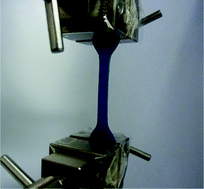Robust biopolymer based ionic–covalent entanglement hydrogels with reversible mechanical behaviour†
Abstract
Emerging applications of hydrogels such as soft robotics and cartilage tissue scaffolds require hydrogels with enhanced mechanical performance. We report the development of a robust biopolymer based ionic–covalent entanglement network hydrogel made from calcium cross-linked gellan gum and genipin cross-linked gelatin. The ratio of the two polymers and the cross-linker concentrations significantly affected the mechanical characteristics of the hydrogels. Hydrogels with optimized composition exhibited compressive fracture stress and work of extension values of up to 1.1 ± 0.2 MPa and 230 ± 40 kJ m−3 for swelling ratios of 37.4 ± 0.6 and 19 ± 1, respectively. The compressive and tensile mechanical properties, swelling behavior (including leachage), pH sensitivity and homogeneity are discussed in detail. Fully swollen hydrogels (swelling ratio of 37.4 ± 0.6) were able to recover 95 ± 2% and 82 ± 7% of their energy dissipation (hysteresis) at 37 °C after reloading to either constant stress (150 kPa) or constant strain (50%), respectively.


 Please wait while we load your content...
Please wait while we load your content...